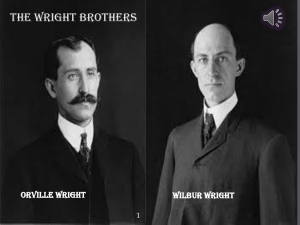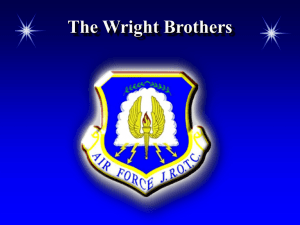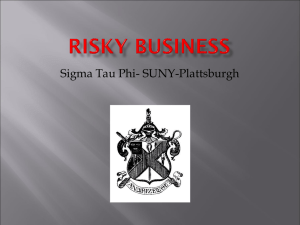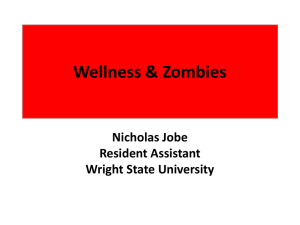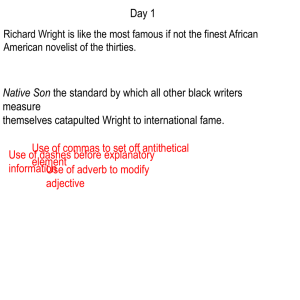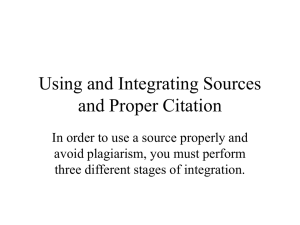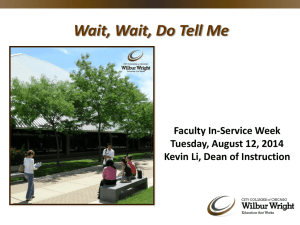The Wright Brothers
advertisement
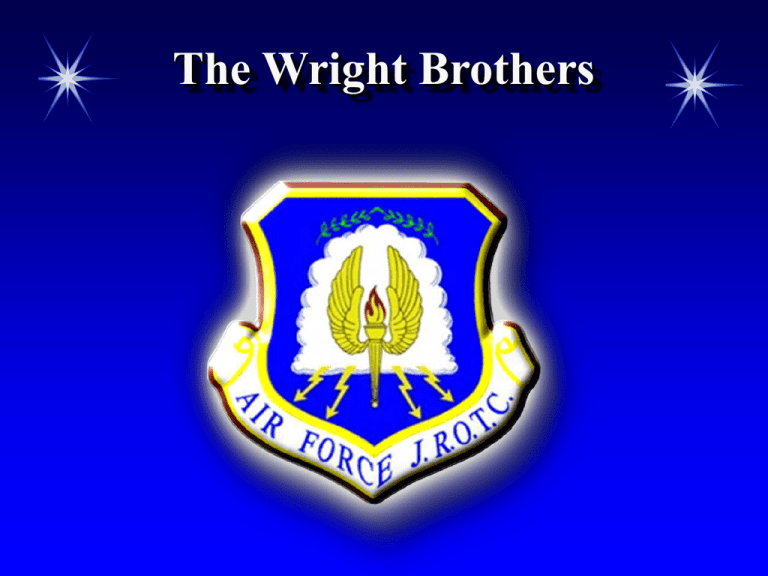
The Wright Brothers Chapter Overview The Wright Brothers Developing Aircraft Chapter 2, Lesson 1 Lesson Overview How the Wright brothers succeeded in the first flight The anatomy of the Wright Flyer The principles of airplane flight The history of the Wright brothers’ involvement with the US Army Chapter 2, Lesson 1 Quick Write As you read in Chapter 1, the Wright brothers were the first to conduct a manned, controlled, sustained, and powered heavier-than-air flight. Many others had tried unsuccessfully to do this. List the reasons for the Wrights’ success. Chapter 2, Lesson 1 How the Wright Brothers Succeeded in the First Flight All pilots face three challenges: Get up in the air Stay up Control the craft Pilots experimented in flight with: Manned and powered, full-size aircraft Models Full-size gliders Chapter 2, Lesson 1 How the Wright Brothers Succeeded in the First Flight The Wrights chose a glider as their starting point They could focus first on balancing and controlling the aircraft Power (an engine) could come later They applied what they learned at each step to make the next one go more smoothly Chapter 2, Lesson 1 Step One: Unmanned Box Kite The Wrights’ kite had A five-foot wingspan and biplane structure Struts that connected the upper and lower wings Bracing strung diagonally between the struts Chapter 2, Lesson 1 Courtesy of the Air Force Historical Research Agency Step One: Unmanned Box Kite They discovered that they didn’t need to tilt an entire wing to turn the craft: Needed to twist only the ends of the wings They called this process “wing warping” In the summer of 1899, Wilbur Wright successfully tested the kite in a field Chapter 2, Lesson 1 Step Two: Manned Gliders Between 1900 and 1902, the brothers built three gliders Before putting a man aboard, they flew each glider like a kite They wanted to test it for control and lift Only after doing this would they put a man aboard Chapter 2, Lesson 1 Wright Gliders The early glider experiments taught the brothers three important things: How to control climb and descent The best design for the shape of the wing How large the wing area had to be to sustain lift Chapter 2, Lesson 1 Courtesy of Wright State University The First Glider (1900) In their experiments in 1900, the Wrights placed an elevator at the front of the glider Earlier designers mounted elevators behind the wings But the Wrights found it easier to control climb and descent when the elevator was placed forward Chapter 2, Lesson 1 The First Glider They also focused on airfoil—a wing’s profile Zeroed in on curve of the wing Tried to design a wing that shifted the center of pressure toward the front edge of the wing Placed the highest point of the wing’s arc closer to the outer edge than to the center— to create greater stability and control Chapter 2, Lesson 1 The First Glider The brothers test-flew their glider at Kill Devil Hills in 1900 It didn’t crash, but clearly improvements were necessary The Wrights headed back to Ohio to build the next version Chapter 2, Lesson 1 The Second Glider (1901) The first glider didn’t have nearly enough lift So for their 1901 glider, the brothers increased the wing area to 290 square feet This glider was also a big disappointment The brothers couldn’t control it well when they tested it at Kill Devil Hills It flew less than 300 feet—time to return to Dayton! Chapter 2, Lesson 1 The Wind Tunnel The brothers built a wind tunnel in their bicycle shop to test model-size wings Made them of sheet steel Cut more than 200 model wings of different shapes Chapter 2, Lesson 1 Courtesy of Wright State University The Third Glider (1902) This glider had two fixed, vertical rudders behind the wings Test flights showed that this resulted in erratic behavior during turns So the Wrights tried a single, movable, vertical rudder This improved control Chapter 2, Lesson 1 The Third Glider The third glider had: Forward elevator Elliptical shape Longer, skinnier wings Wing area of 305 feet Low angle of attack This design was a success The brothers took to the air in the North Carolina dunes more than 700 times in the fall of 1902 Chapter 2, Lesson 1 Courtesy of NASA Step Three: A Manned, Powered Aircraft The brothers set out to fit their plane with an engine They tried to buy one ready made But no one met their needs or price So they had their bicycle mechanic, Charles E. Taylor, build them a fourcylinder, 12-horsepower engine Chapter 2, Lesson 1 The 1903 Engine viewed from the side Courtesy of the Library of Congress Delays In September 1903 they returned to Kitty Hawk and Kill Devil Hills First they had to build a trolley track to give their powered aircraft a running start Bad weather also caused delays The brothers tossed a coin, and Wilbur won However, on the first test flight of the Wright Flyer, he crashed it It took three days to repair the damaged craft Chapter 2, Lesson 1 First Flight! On 17 December, Orville took the controls The Flyer rose into the air and stayed aloft for 12 seconds and traveled 120 feet Orville had made the first controlled, sustained, heavier-than-air human flight with a powered aircraft The brothers took turns piloting the Flyer for three more flights The fourth and final launch lasted 59 seconds, and the craft traveled 852 feet Chapter 2, Lesson 1 Anatomy of the Wright Flyer Equipped with an engine and propellers Biplane with wingspan of 40 feet, four inches, and a wing area of 510 square feet Wings had spars and ribs (covered in muslin) Struts and bracing between top and bottom wings Plane also had a front elevator Rudder at the rear (covered in muslin) Skids rather than wheels Chapter 2, Lesson 1 Anatomy of the Wright Flyer Chapter 2, Lesson 1 Courtesy of Wright State University How the Flyer Worked The brothers controlled their craft with: the forward elevator the use of wing warping and a single, movable rear rudder Surprisingly, the pilot did not sit upright The pilot lay on his stomach in a padded cradle on the lower wing Chapter 2, Lesson 1 Courtesy of Comstock Images How the Flyer Worked To the pilot’s left was a lever that he used to control the up-and-down movement of the elevator By moving his hips, he pulled on the cables connected to the wings and rudder (directing the plane left or right) With the new, flexible rudder, the plane finally turned in the intended direction The cables attached to the wings twisted one wing down while forcing the other wing up Chapter 2, Lesson 1 Principles of Airplane Flight To get the Wright Flyer off the ground, the brothers had to solve the principles of flight: Lift Drag Thrust Angle of attack Center of pressure Airfoil Relative wind Orville and Wilbur assembling the 1903 Flyer (detail) Chapter 2, Lesson 1 Courtesy of “Wright State University Principles of Airplane Flight An engine and propellers gave Wilbur and Orville the ability to use not only lift but also thrust to propel their plane Vertically mounted propellers could provide the airflow for thrust They needed 90 pounds of thrust to propel the Wright Flyer Their 12-horsepower engine and the large propellers proved equal to the task Chapter 2, Lesson 1 Wright Brothers’ Involvement With the US Army The Wright brothers continued refining their airplane In January 1905, they had contacted their representative in Congress (R. M. Nevin) and tried to interest the US government in buying their airplane Their offer was turned down Chapter 2, Lesson 1 Wright Brothers’ Involvement With the US Army The British and French governments were interested in buying the Flyer But the brothers wanted the US government to have the first crack at owning a Wright Flyer On 22 May 1906 they received a government patent for their invention Chapter 2, Lesson 1 The Wright Brothers’ Patent Chapter 2, Lesson 1 Courtesy of the U.S. Air Force Bids for a Government Plane On 23 December 1907, Gen James Allen sent out a request for bids to build a plane for the government The Wright Flyer met the bid requirements Orville Wright signed a contract on 10 February 1908 selling the Flyer to the US government Chapter 2, Lesson 1 Ways the Wright Brothers Contributed to Army Aviation Orville spent much of 1908 and 1909 improving the Flyer He made more test flights and took up military passengers One such flight tragically ended in a crash that seriously injured Orville and killed 1st Lt Thomas Selfridge—the first US military aviation casualty Chapter 2, Lesson 1 Ways the Wright Brothers Contributed to Army Aviation The brothers switched roles in mid-1909 Wilbur trained two pilots for the Army—1st Lt Frank P. Lahm and 2d Lt Fredric E. Humphreys A third pilot, 1st Lt Benjamin Foulois, got instruction late that month Foulois went on to achieve the rank of major general and was also chief of the Army Air Corps Chapter 2, Lesson 1 Army Airplanes It took a while for the Army to decide how to use airplanes during war At first, the Army thought that airplanes would be useful only for aerial reconnaissance World War I brought about a change in strategy But before that could happen, airplanes needed improvements to make them faster, sturdier, and more reliable Chapter 2, Lesson 1 Review The Wrights choose a glider as their starting point They began in July 1899 with an unmanned box kite Between 1900 and 1902, the brothers built three gliders—first flying them like a kite, then putting a man aboard Chapter 2, Lesson 1 Review The early glider experiments taught the brothers three important things: How to control climb and descent The best design for the shape of the wing How large the wing area had to be to sustain lift Once the Wrights had resolved questions about control and lift, they set out to fit their plane with an engine Chapter 2, Lesson 1 Review On 17 December 1903 Orville made the first controlled, sustained, heavier-thanair human flight with a powered aircraft The brothers controlled their craft through three main means: The forward elevator The use of wing warping A single, movable rear rudder Chapter 2, Lesson 1 Review On 22 May 1906 the brothers received a government patent for their invention On 10 February 1908 they sold the Wright Flyer to the US government It took a while for the Army to decide how to use airplanes during war Airplanes needed improvements to make them faster, sturdier, and more reliable Chapter 2, Lesson 1 Summary How the Wright brothers succeeded in the first flight The anatomy of the Wright Flyer The principles of airplane flight The history of the Wright brothers’ involvement with the US Army Chapter 2, Lesson 1 Next…. Done—the Wright brothers Next—developing aircraft Chapter 2, Lesson 1 Courtesy of NASA

